Sexual Reproduction in Flowering plants
Flowers have always been objects of fundamental, social, religious and cultural values, they have always been used as symbols
for conveying human feelings like love, affection happiness and grief. But for a botanist flowers are morphological and
embryological marvels and site of reproduction.
Watch now lecture :- sexual reproduction in flowering plants
Structure of a flower: the main parts of a flower as follows:
👉 Receptacle: it is the base of a flower to which all flower parts are attached.
👉 Sepal: the outermost circle of a flower that is green and leafy. Together it is known as calyx and they function to protect the flower in bud form.
👉 Petals: the second whorl after sepals, together they are called as corolla. They function to protect the reproductive structures and attract the insects for pollination as they are colourful and scented.
👉 Stamen: it the male reproductive part of the flower. It is made of two parts, the anther and the filament, the anther
synthesizes and stores the pollen grains, it is also called as androecium.
👉 Pistil: the female reproductive part. It is differentiated into three parts, the style, stigma and the ovary. Also called as gynoecium

Pre-fertilisation: Structure and Events
👉 The development of the floral primordium is influenced by a number of structural and hormonal changes. An inflorescence is created, which bears floral buds before flowering.
👉 Male (androecium) and female (gynoecium) gametes are created in flowers as theyd ifferentiate and mature.
👉 Stamen, Microsporangium and Pollen grains Stamens is a long and a thin stalk called the filament and bilobed anthers.
👉 Each lobe hast wo theca (dithecious). The anther is a four-sided structure with two microsporangia in each lobe.
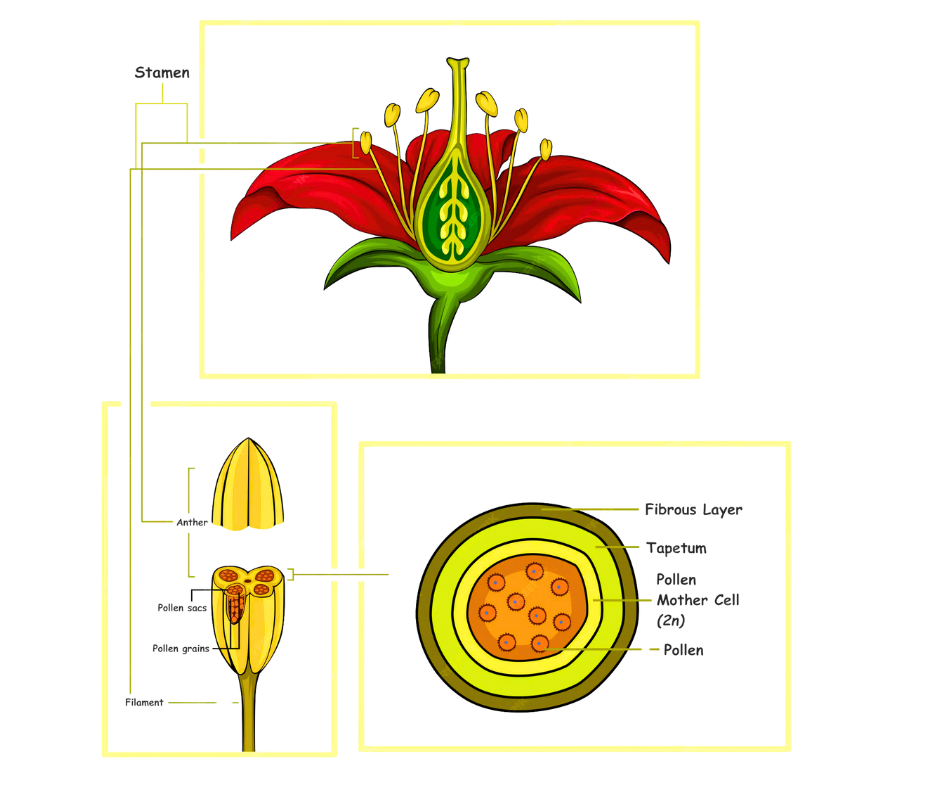
Development in microsporangia takes place and they become pollen sacs filled with pollen grains.
👉 The epidermis, endothecium, middle layer, and tapetum are the four layers that surround the microsporangium. The outer three wall layers perform the function of protection and help in dehiscence of anther to release the pollen. The tapetum in the innermost layer that nourishes the growing pollen grains.
👉 The sporogenesis tissue: When the anther is young, it has compactly organised homogeneous cells in the centre of each microsporangium called the sporogenesis tissue.
👉 Microsporogenesis: it is the process of formation and differentiation of microspores (pollen grains) from microspore mother cells (MMC) by reductional division.
👉 Sporogenous tissue divides meiotically to create microspore tetrads. The microspore dissociates and develops into pollen grains when the anther matures and dehydrates.
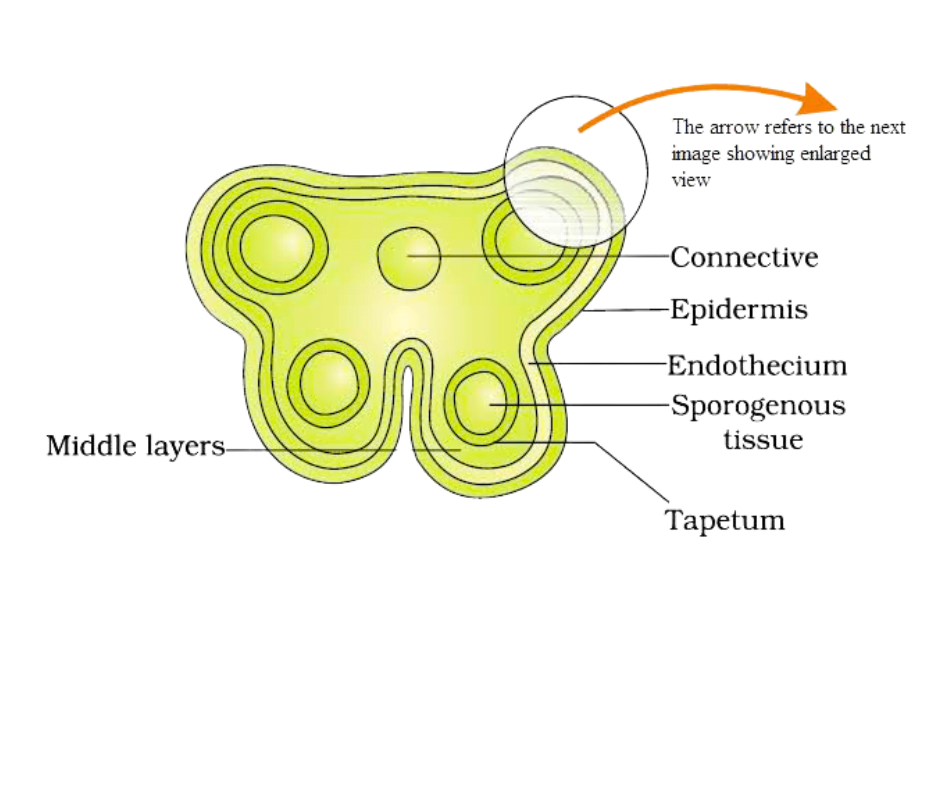
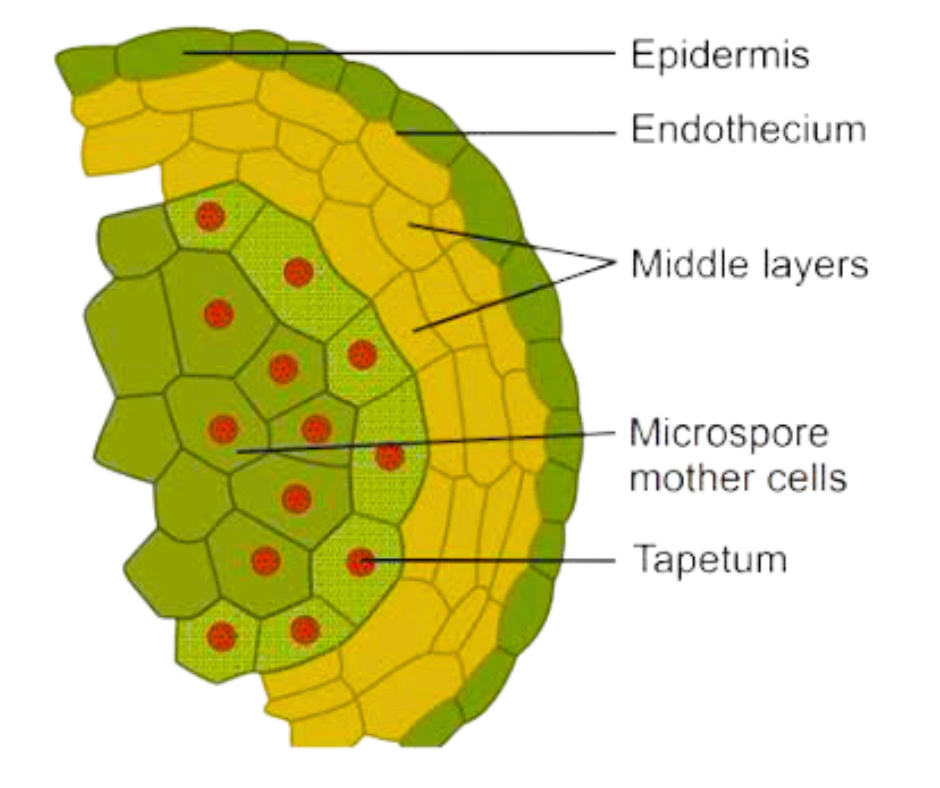
Diagram showing a transverse section of an anther enlarged view of Microsporangium showing the walls
Q1. What would be the ploidy of the cells of tetrad?
(a) Haploid (b) Diploid
(c) Polyploid (d) Triploid
Ans. 1. (a)
Q2. The microsporangia develop further and become pollen sacs. In anther these pollen sacs extend.
(a) Transversely (b) Longitudinally
(c) Obliquely (d) Sometimes transversally and sometimes longitudinally
Ans. 2. (b)
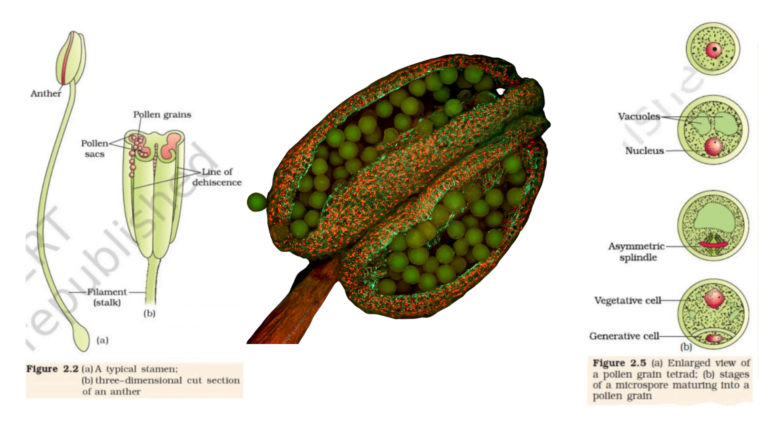
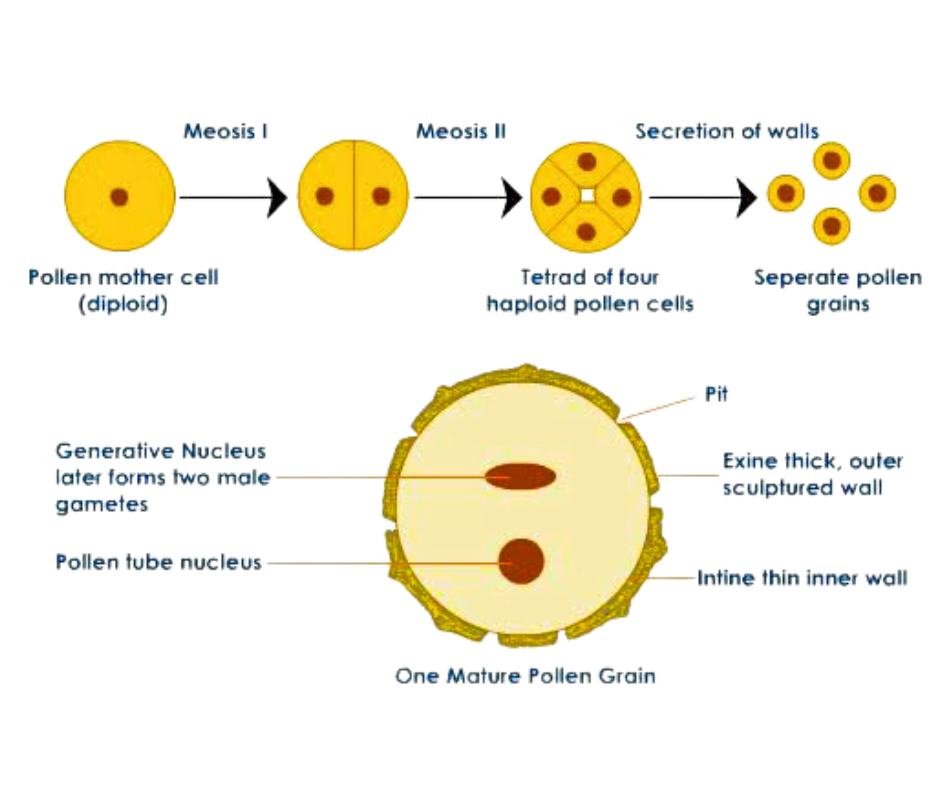
👉 The Pollen grain: it represents the male gametophyte.It is surrounded by two walls:
✍️ (i) Exine: it is made from sporopollenin, the most resistant biological substance known to man. It is resistant to high temperatures as well as strong acids and alkalis. Sporopollenin cannot be degraded by any enzyme
✍️ (ii) Intine: it is a thin and a continuous layer of cellulose and pectin.
👉 Germ pore helps in formation of the pollen tube during pollen germination via the exine where sporopollenin is absent.
✍️ The mature pollen grain: at maturity a pollen contains two cells the-
👉 (i) vegetative cell: it is bigger and has abundant food reserve, has a large nucleus and is responsible for the development of pollen grain.
✍️ (ii) generative cell: it is small and is involved in syngamy, it has a dense cytoplasm and a nucleus.
👉 More about pollen grains: Pollen grains from various species, such as Parthenium, cause severe allergies and bronchial illnesses in certain people, leading to persistent respiratory problems such as asthma and bronchitis.
👉 Pollen grains are high in nutrients and are used as dietary supplements in the form of pollen tablets. Pollen grain viability
varies in species. A pollen grain should settle on stigma before this period so that it can germinate. Pollen grains from a variety of species are preserved in liquid nitrogen at a temperature of – 196 degrees in a pollen bank.
Q1. To some extent viability of pollen grains depends on.
(a) Temperature (b) Humidity
(c) Both (a) and (b) (d) Light
Ans. 1. (c)
Q2. Due to which of the following chemical deposition pollen
grains are well preserved as fossils.
(a) Pollen kit (b) Callose
(c) Sporopollenin (d) Pecto-cellulose
Ans. 2. (c)
The Pistil, Megasporangium (Ovule), the embryo sac
👉 A gynoecium can have a single pistil (monocarpellary) or several pistils (polycarpellary), which can be united (syncarpous) or free (apocarpous) e.g. multi carpellary and syncarpous pistil is present in Paver somniferum and multi carpellary and apocarpous pistils is found in Michelia.
Each pistil is made up of three parts: the stigma, the style, and the ovary.
👉 The ovarian cavity is located within the ovary (locule). The placenta is positioned within the ovarian cavity. Megasporangia (ovules) develop from the placenta.
The ovule/megasporangium: The ovule is a tiny structure that is connected to the placenta. It is characterised by the following:
Funicle: it is a stalk that connects the ovule to the placenta.
Hilum: it is the connection between the ovule and the funicle. Protective envelops around the ovule is known as integuments.
Micropyle: it is a small hole at the apex of the ovule via which the pollen tube enters
Chalaza: it is the ovule’s basal portion.
Nucellus (2n): it is a collection of cells surrounded by integuments and has a large food reserve.
Megasporogenesis: it is the process of formation of a megaspore from a megaspore mother cell by meiotic division and occurs within the ovule. In the nucellus’ micropylar region, an ovule develops a single megaspore mother cell (MMC). MMC passes through meiotic division, resulting in the formation of four megaspores.
👉 Three megaspores degenerate in the majority of blooming plants. One megaspore matures into a female gametophyte (embryo sac).
👉 The functional megaspore nucleus splits mitotically to create two nuclei that migrate to opposing poles to form a two-nucleate embryo sac. Two further mitotic divisions culminate in an 8-nucleate embryo sac.
👉 Six of the eight nuclei are enclosed by cell wall, with the other two (polar nuclei) located beneath the egg apparatus. Three cells create the egg apparatus at the micropylar end, and three cells form antipodal cells at the chalazal end. Thus the embryo sac is 8-nucleate and 7-celled in maturity.
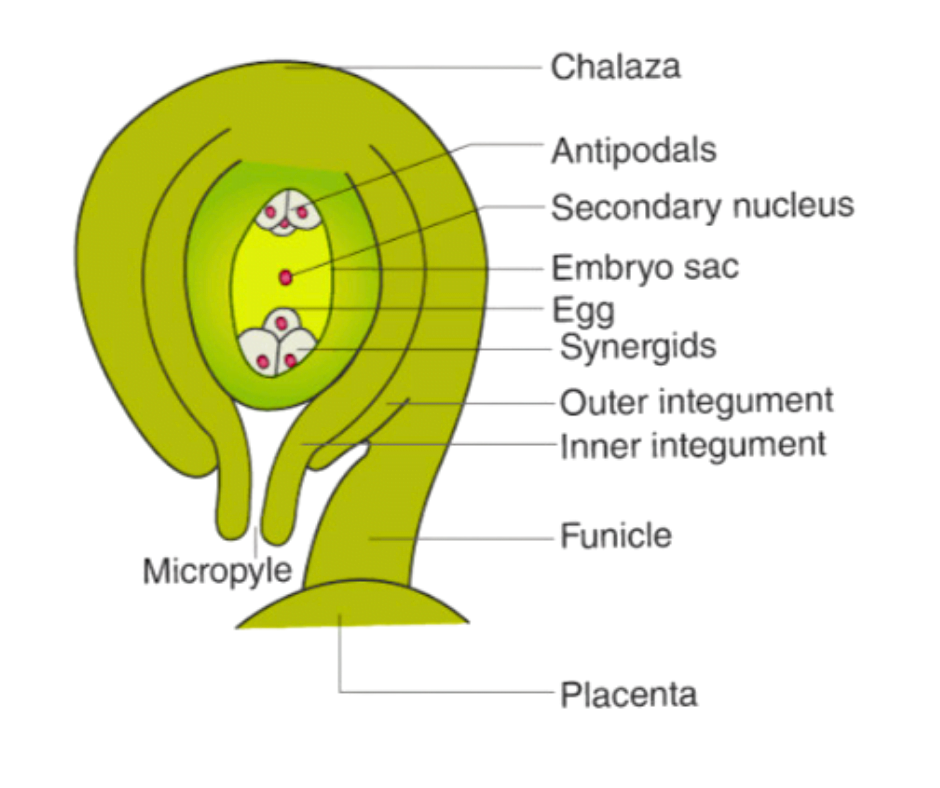

A typical anatropous ovule
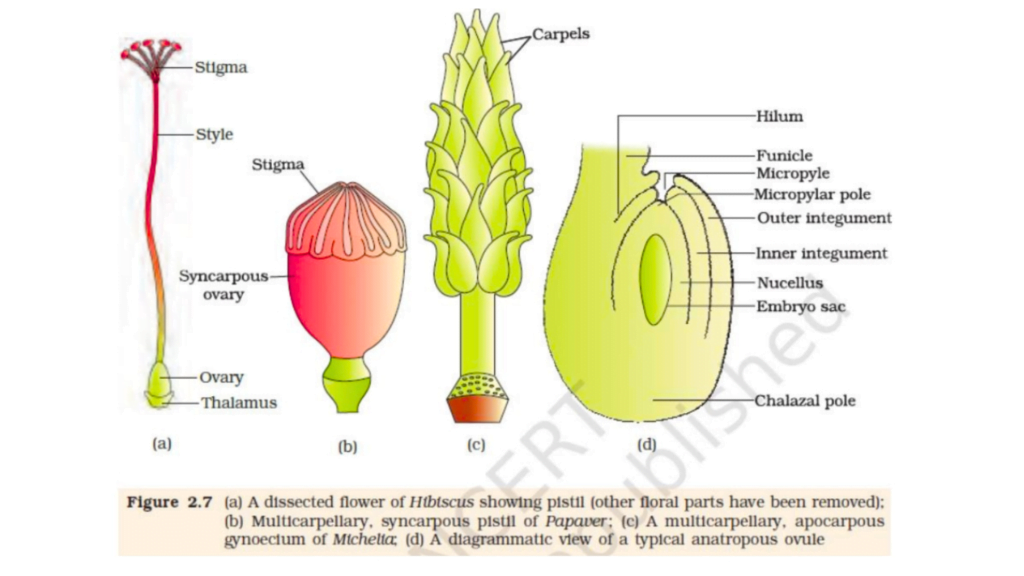
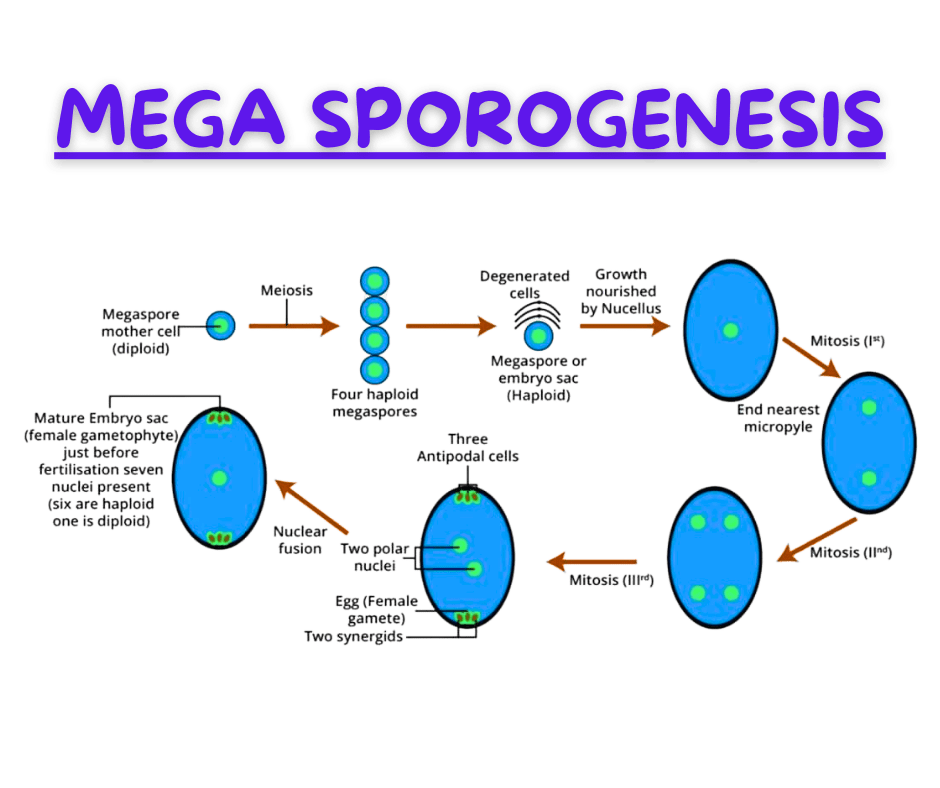
Q1. Choose the number of diploid structures in the list given below. Pollen grains, nucellus, perisperm, endosperm, embryo-sac, megaspore
(a) Two (b) Three (c) Four (d) One
Ans.1. (a)
Q2. Select the odd one out.
(a) Pollen grains (b) Antipodal cells
(c) Synergids (d) Egg cell
Ans. 2. (a)
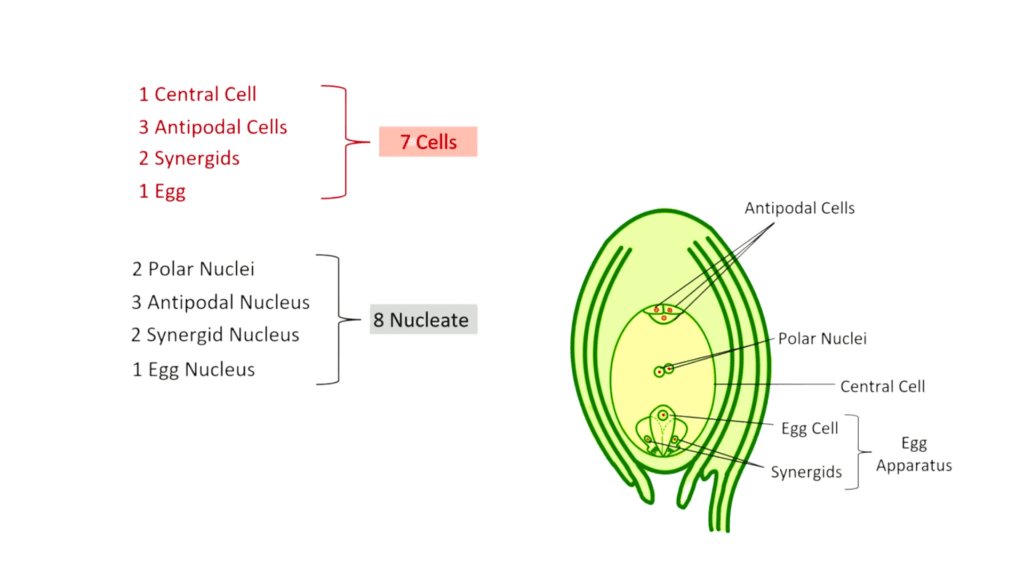
Pollination:
👉 Transfer of pollen grains from the anther to the stigma is called pollination. It is of the following types:
Autogamy: it is the transfer of pollen grains from the anther to the stigma of the same flower. It is seen in cleistogamous flowers.
Cleistogamous flowers: these flowers do not open at all as there is no probability of cross-pollen landing on the stigma, they are autogamous. Even in the absence of pollinators, cleistogamous flowers yields certain seed-set. Viola (common pansy), Oxalis, and Commelina are a few examples.
Chasmogamous flowers: their anthers and stigma are exposed.
Geitonogamy: Pollen grains are transferred from the anther to the stigma of a separate flower of the same plant. Geitonogamy is cross-pollination with a pollinating agent that is genetically identical to autogamy since the pollen grains come from the same plant.
Xenogamy: Pollen grain transfer from anther to stigma of a different plant’s flowers on the same species.
Agents of Pollination: includes biotic and abiotic factors.
Biotic factors include butterfly, honeybee, insects and abiotic like water and wind.
Wind pollination: it is also called as anemophily, the pollen grains are light in weight, sticky and winged. The anthers are well exposed, stigma is large and feathery and flower has a single ovule arranged in an inflorescence. The flowers of such pollinated plants do not produce nectar and pollen grains are also produced in large quantity. E.g. corn cob, date palm and cotton.
Water pollination: it is also called as hydrophily. The pollen grains in this case is well protected by a mucilaginous covering. The flowers in this case also are devoid of nectar and pollen are produced in large quantity. E.g. vallisneria, hydrilla and zoestra.
Insect Pollination: it is also called as entomophily. Flowers in this case are large, colourful and scented and the pollen grains and stigma are sticky. E.g. amorphophalus and yucca.
Outbreeding devices: As continuous self-pollination leads to inbreeding depression, several mechanisms prevent self- pollination and stimulate cross pollination.
Some the mechanisms are as follows:
• No synchronisation between pollen release and stigma receptivity.
• Positions of anther and stigma are different.
• Pollen does not germinate on pistil if of any other species.
• Presence of unisexual flowers.
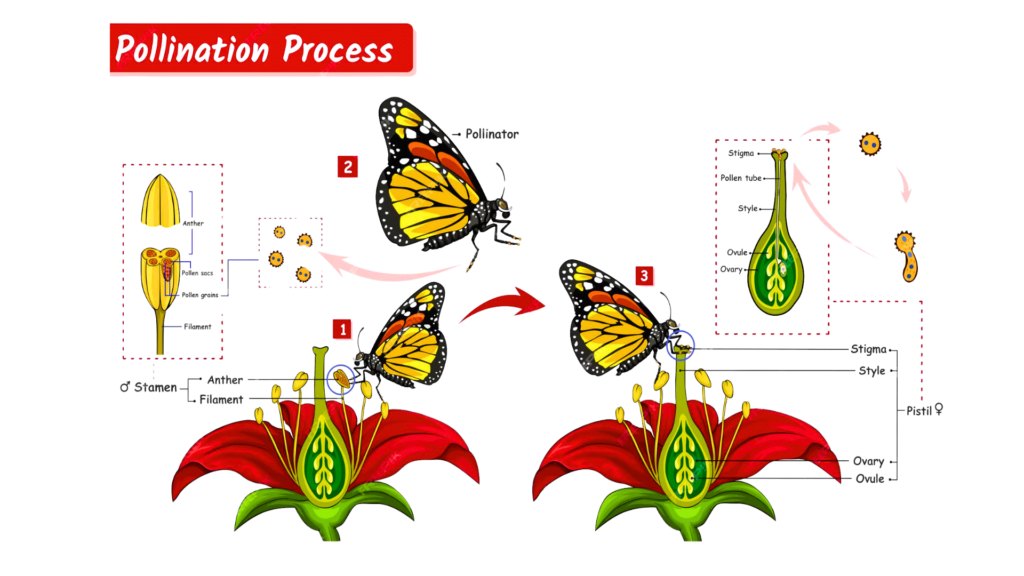

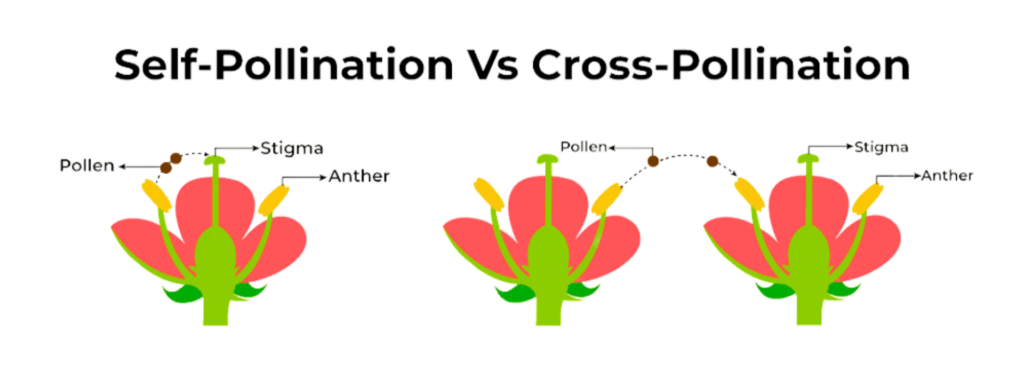
Pollen-pistil interaction:
👉 The pistil recognises suitable pollen and initiates post pollination activities that lead to fertilisation. Pollen grain generates pollen tube through germ pores to assist male gamete transfer to the embryo sac.
👉 L.S of a flower showing pollen germination on the stigma of a flower The pollen has the ability to recognise the correct pollen grains. If pollen is of right type then it leads to fertilisation.
👉 The pollen after landing on the stigma grows through the tissues and style reaches the ovary.
👉 In plants, the pollen that get shed at the two celled stage, the generative cell divides to give rise to two male gametes during the growth of the pollen tube in the stigma.
👉 In plants in which the pollen are shed at three celled stage, the pollen tube carries the male gametes from the beigning.
👉 Pollen tube enters the ovule through the micropyle, and then enters one of the synergids through the filiform apparatus.
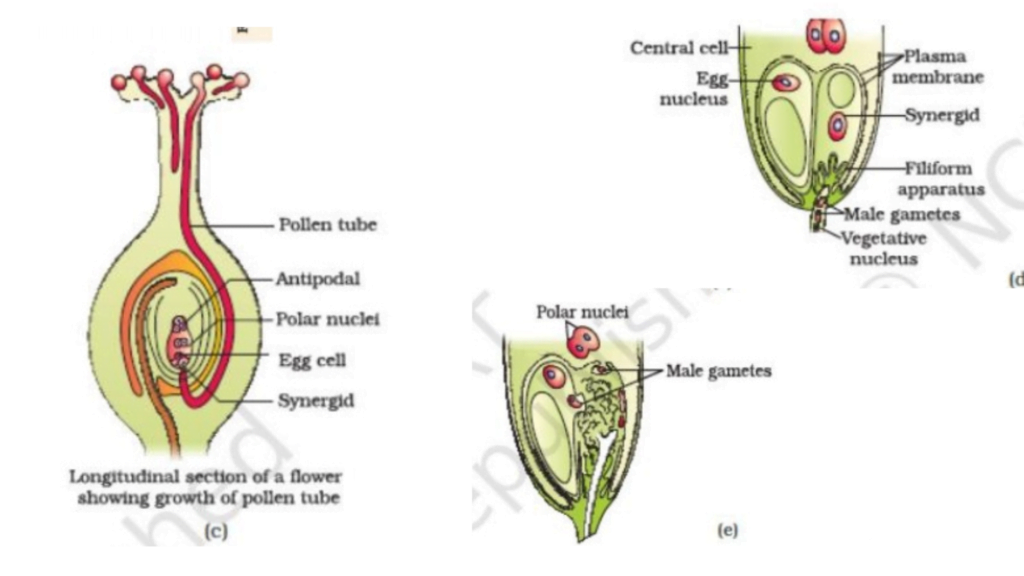
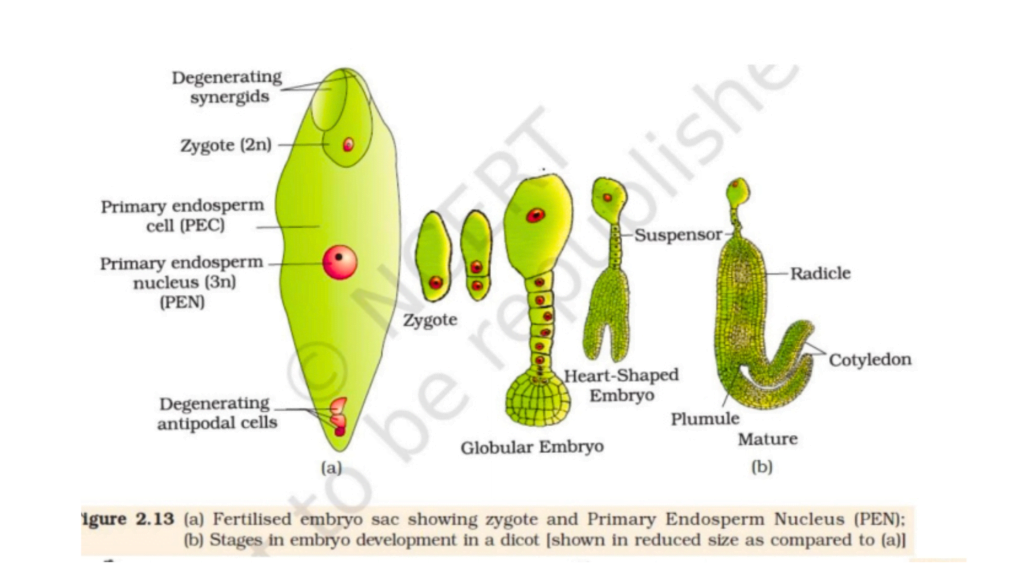
Enlarged view of egg apparatus showing the entry of pollen tube
Q1. Pollen tube develops from.
(a) Generative cell (b) Male gametes
(c) Vegetative cell (d) Vegetative nucleus
Ans. 1. (c)
Q2. When pollen grains of a flower are transferred to stigma
of another flower of a different plant, the process is called.
(a) Geitonogamy (b) Xenogamy
(c) Autogamy (d) Homogamy
S2. (b)
Artificial hybridisation: it is a mode of crop improvement programme, in crossing experiments it is important to make sure that only the desired pollen grains are used for pollination and the stigma is protected from contamination (unwanted pollen grains), this is achieved by:
Emasculation: IF the female parent bears bisexual flowers, removal of anthers from the flower buds before the anther dehisces using a pair of four steps is necessary, this step is called as an emasculation.
Bagging technique: the emasculated flowers have to be covered with a bag of suitable size generally made up of butter paper to prevent contamination of its stigma with unwanted Pollen Grain, this process is called as bagging.
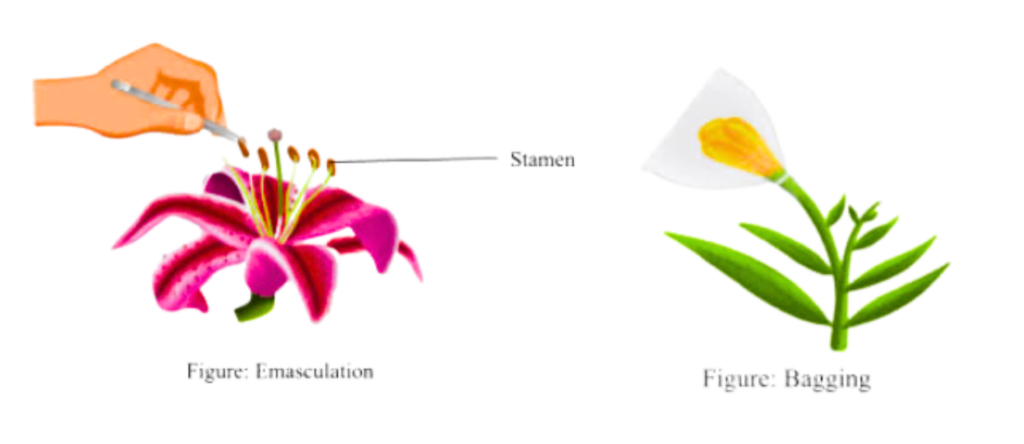
Double Fertilisation:
👉 Each pollen grain produces two male gametes after entering one of the synergids. To form a triploid main endosperm nucleus, one male gamete fuses with an egg (syngamy) and another male gamete fuses with two polar nuclei (triple fusion) (PEN). Because two forms of fusion occur in an embryo sac, the event is known as double fertilisation. The PEN becomes the endosperm, and the zygote becomes the embryo.
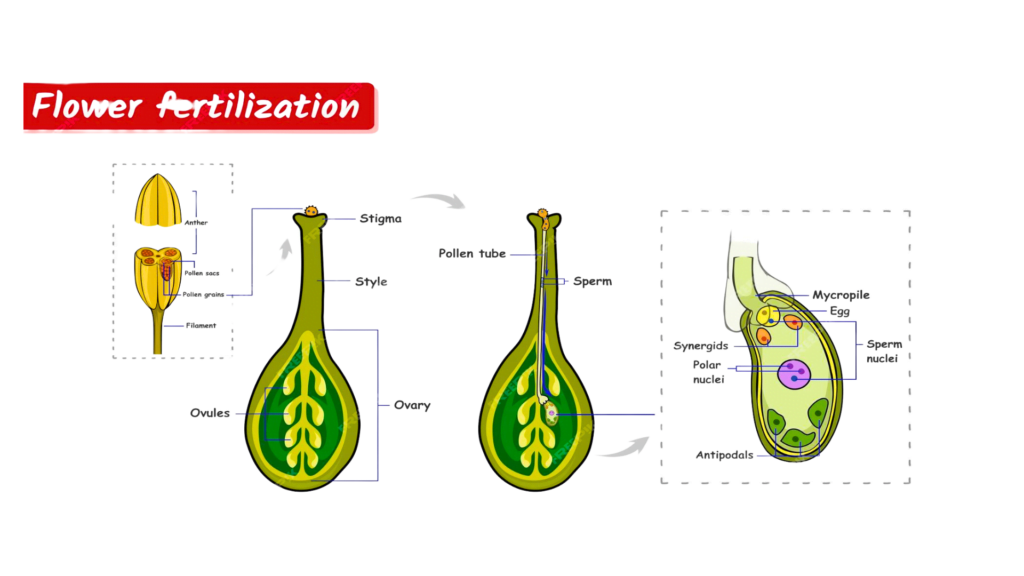
Q1. The primary endosperm nucleus.
(a) Haploid (b) Diploid
(c) Triploid (d) Tetraploid
Ans. 1. (c)
Q2. The main embryo is developed as a result of.
(a) Pollination
(b) Triple fusion
(c) Syngamy
(d) Fusion of two polar nuclei of an embryo sac
S2. (c)
Post-fertilisation structures and events: it includes endosperm and embryo development, maturation of ovule into seed, and the ovary into fruit.
Endosperm: The original endosperm cell multiplies multiple times to generate triploid endosperm tissue with reserve food resources. There are two kinds of endosperm development:
(i) Free nuclear type (common method)
(ii) Cellular type
The endosperm may be totally used before seed maturation (non-albuminous) for example, pea, groundnut or a part of the endosperm may also remain in mature seeds (albuminous. E.g. wheat and castor.
Embryo: the early stages of embryo development is called as embryogeny. The zygote gives rise to a pro-embryo, which then develops into the globular, heart-shaped, mature embryo.
Dicot embryo: consists of a embryonal axis and two cotyledons. Epicotyl is the portion above the cotyledons and terminates at the plumule and hypocotyl is the portion below the cotyledons and terminates at the radicle. Root tip is covered by a root cap.
Monocot embryo: Have only one cotyledon, that too of the grass family is called scutellum and is situated at the lateral side of the embryonal axis. At the lower end, the embryonal axis has the radicle and the root cap that is enclosed by a sheath called coleorhiza. The portion above the level of attachment of scutellum is the epicotyl that has a shoot apex and
few leaf primordia enclosed in a hollow structure called coleoptile.
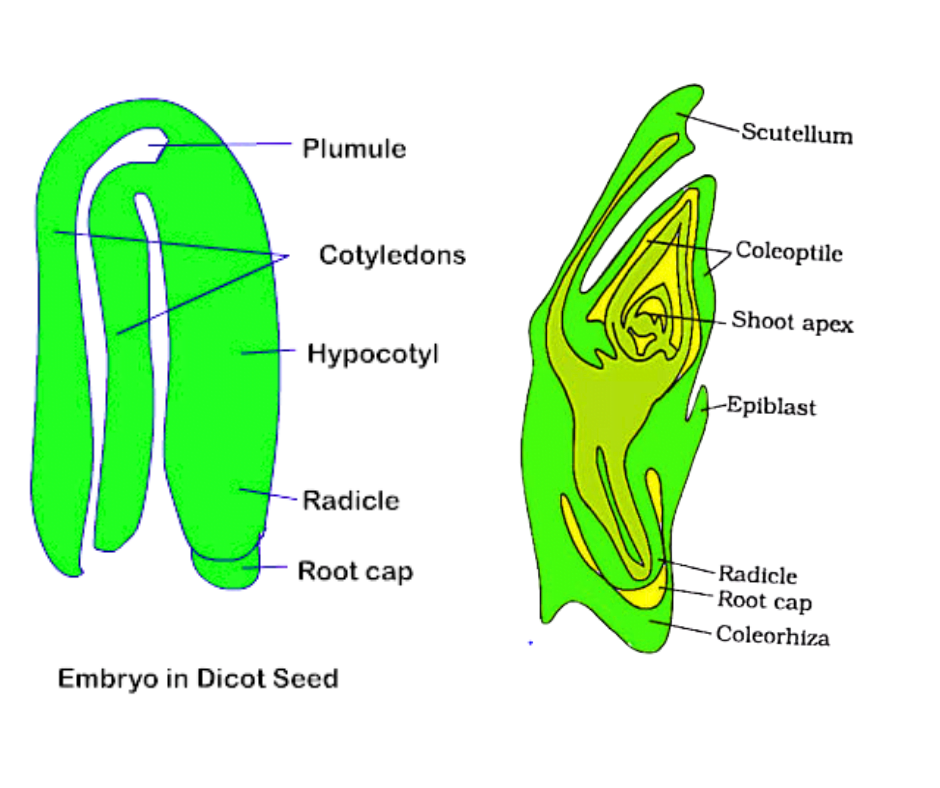
Seed: it is the fertilized and mature ovule develops into seed.
It consists of:
👉 cotyledon(s)
👉 embryonal axis
👉 Seed coat- double layered- formed by integuments, testa (outer coat) and tegmen (inner coat). Seed can be albuminous or ex-albuminous.
👉 Other features of a seed are:
Micropyle:- it is a small opening on seed coat that facilitates entry of water and oxygen into seeds (for germination).
Hilum:- it is a scar on seed coat.
Perisperm: remnants of nucellus that is persistent. Ex: Black pepper
Dormancy: state of inactivity.
👉 The ovary wall develops into the fruit wall known as the pericarp. Only the ovary contributes to fruit formation in true fruits, whereas the thalamus also contributes to fruit formation in false fruits.
Apomixis: when seeds are produced without fertilisation. E.g. species of Asteraceae and grass. It is a form of asexual reproduction that mimics sexual reproduction.
Ways of development of apomictic seeds:
👉 the diploid egg cell form without reduction division and develop into the embryo without fertilization
👉 In many citrus and mango varieties, some of the nucleus cells surrounding the embryo sac start dividing, protruding into the embryo sac and develop into the embryo, this is call ed polyembryony. .
Thanks 🙏
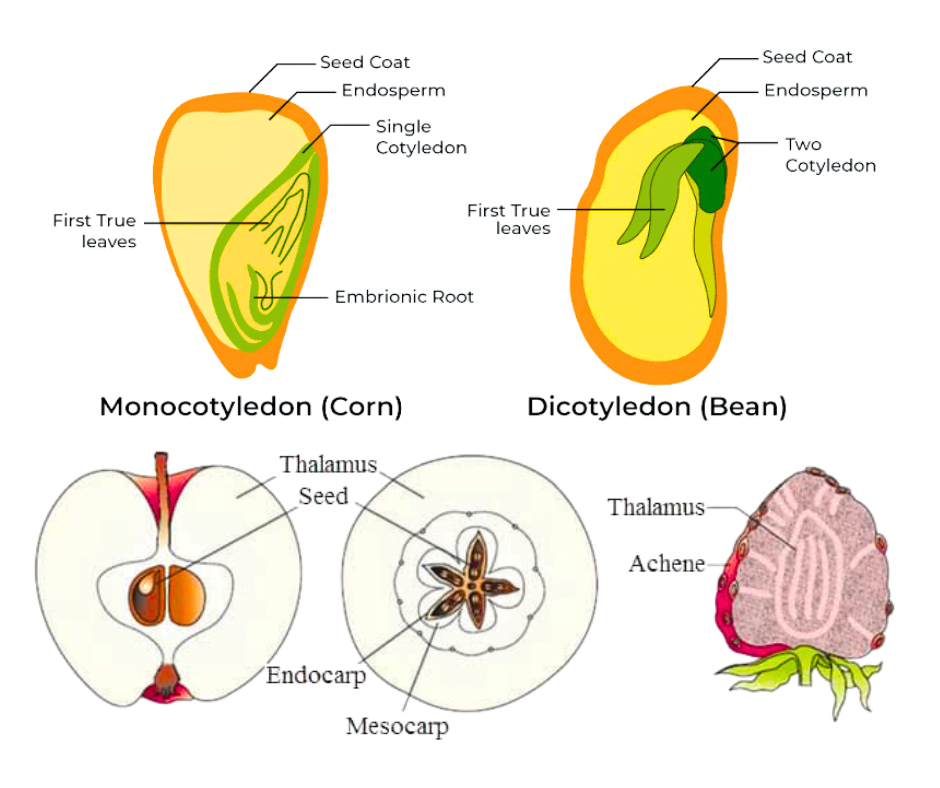





 Jhunjhunu, Rajasthan (India) – 333025
Jhunjhunu, Rajasthan (India) – 333025